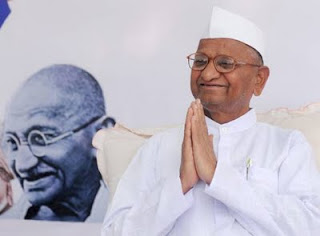Anna Hazare, an anti-corruption activist in India, has been sitting on indefinite fast since the last eleven days. Being a Gandhian by philosophy he applies non-violent means of protest to raise his concerns. I have been closely following on the developments since his fast began and therefore was tempted to write this blog about fasting metabolism.
Fasting as a political tool has been used since a long time and was popularized by Mahatma Gandhi whose longest fasts went up to a period of three weeks. Since then it continues to inspire many activists throughout the world, one of the famous being Kieran Doherty's hunger-strike in Northern Ireland which lasted 73 days!

Anna Hazare during his indefinite fast at Ramlila Maidan.
So, how long can a person stay alive with only water and no food?
A general estimate for a normal healthy male would be about 35-40 days, however there have been no controlled studies in this direction due to obvious ethical reasons. The survival would of course largely vary between individuals, depending on their genetic makeup, body condition, age and other factors. Females could survive much longer than males owing to a higher fat to protein ratio (since fats are more calorie dense than proteins). When the body is depleted of exogenous nutrients, it starts mobilizing the fat and protein stores to meet maintenance energy needs. Calorically speaking, a person could survive as long as all the fat and protein reserves last, however once the micronutrients such as vitamins become limiting, survival is compromised.
Exogenous glucose lasts for up to 5 hrs once fasting has commenced. Once all the glucose is depleted, the energy needs of metabolism are met by glucose derived from glycogen stored in the liver and muscle. Glucose from glycogen can serve as a dominant energy source for up to 1 d, after which renal and hepatic gluconeogenesis from adipose fat and muscle protein start taking over.
The liver converts fats into ketone bodies, mainly β-hydroxy butyrate and acetoacetate, a process called ketosis. The capability of long-term survival in humans really depends on the adaptability of human brain to utilize these ketone bodies as the main energy source. The glycerol produced on release of free fatty acids can directly be used for gluconeogenesis.
After two days of starvation, about 60% of the glucose is supplied by liver. The main sources for glucose synthesis in liver are alanine from muscle, glycerol from lipolysis and recycled lactate and pyruvate. The remaining 40% of glucose needs is met by the kidney using glycerol from adipose and glutamine from muscle. A prolonged starvation might be fatal mainly due to organ failure, as is the case in anorexia.
Ancient medicinal systems like Ayurveda recommend short term fasting to detoxify and purge the body of unwanted chemicals. There can also be several physiological benefits from short-term fasting. Large amount of literature is now available to show the significance of calorie restriction in extending life span. Other benefits of fasting could be lower risk of heart diseases and higher insulin sensitivity. Fasting is also used as a spiritual tool to turn one's mind inwards into introspection and self-inquiry, and thus is practiced in many religions. However, there can be various associated side effects like nausea, headaches and muscle aches, and therefore a physician’s advice is recommended.
I would like to end with a quote by Mark Twain which says, "A little starvation can really do more for the average sick man than can the best medicines and the best doctors."
__________________________________
References:
http://www.annualreviews.org/doi/pdf/10.1146/annurev.nutr.26.061505.111258
http://www.scientificamerican.com/article.cfm?id=how-long-can-a-person-sur&page=2
Image from:
http://www.freepressjournal.in/tfp_cms/gall_content/2011/8/2011_8$largeimg217_Aug_2011_202432967.jpg

No comments:
Post a Comment